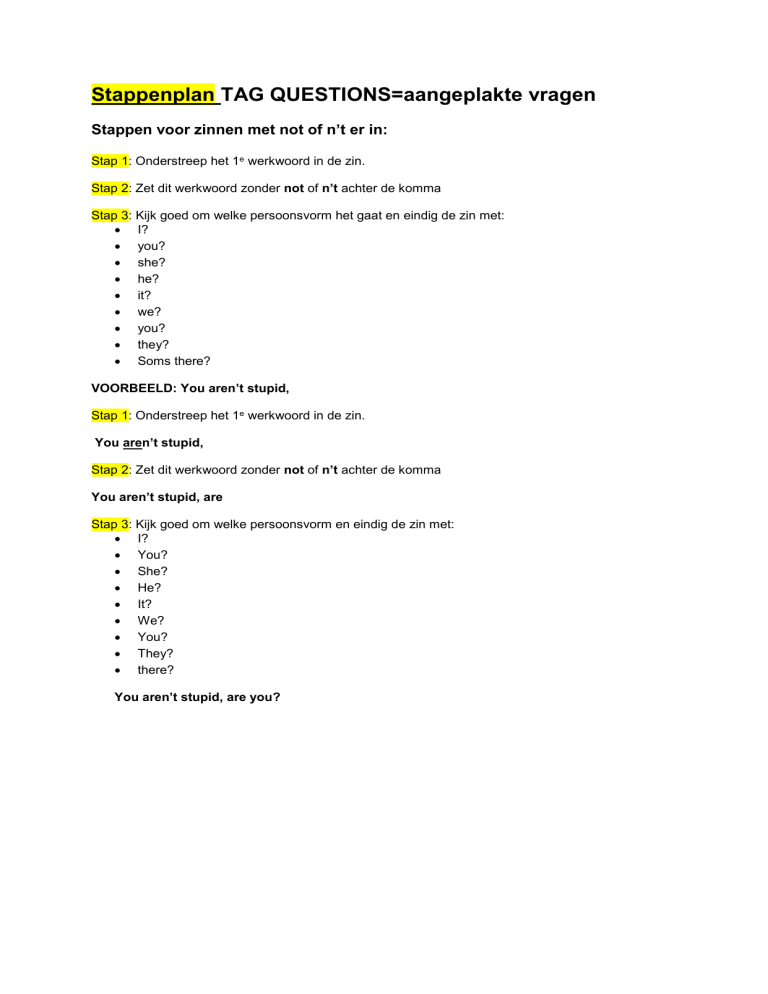
Stappenplan TAG QUESTIONS=aangeplakte vragen
Stappen voor zinnen met not of n’t er in:
Stap 1: Onderstreep het 1e werkwoord in de zin.
Stap 2: Zet dit werkwoord zonder not of n’t achter de komma
Stap 3: Kijk goed om welke persoonsvorm het gaat en eindig de zin met:
I?
you?
she?
he?
it?
we?
you?
they?
Soms there?
VOORBEELD: You aren’t stupid,
Stap 1: Onderstreep het 1e werkwoord in de zin.
You aren’t stupid,
Stap 2: Zet dit werkwoord zonder not of n’t achter de komma
You aren’t stupid, are
Stap 3: Kijk goed om welke persoonsvorm en eindig de zin met:
I?
You?
She?
He?
It?
We?
You?
They?
there?
You aren’t stupid, are you?
Stappen voor zinnen zonder not of n’t er in:
Stap 1: Onderstreep het 1e werkwoord in de zin.
Stap 2: Als dit een hulpwerkwoord is dan zet je het achter de komma.
Ga anders verder bij stap 5.
Hulpwerkwoorden:
to be (am, is, are, was, were)
to have (have, has, had)
to do (do, does, did)
shall & will
should & would
can & may
could & might
must& ought
be able to (am, is, are, was, were able to)
Stap 3: Zet n’t achter het werkwoord.
!shall –> shan’t
will->won’t
Stap 4: Kijk goed om welke persoonsvorm het gaat en eindig de zin met :
I?
you ?
she ?
he ?
it?
we ?
you ?
they ?
there ?
Stap5 :
Staat het werkwoord in de tegenwoordige tijd zet dan don’t of doesn’t + de juiste persoonsvorm
achter de komma.
Staat het werkwoord in de verleden tijd zet dan didn’t + de juiste persoonsvorm achter de komma.
Kies uit:
TT
- don’t I ?
- don’t you?
- doesn’t she ?
- doesn’t he ?
- doesn’t it?
- don’t we ?
- don’t you ?
- don’t they ?
- doesn’t there ?
VT
- didn’t I?
- didn’t you?
- didn’t she?
- didn’t he?
- didn’t it?
- didn’t we?
- didn’t you?
- didn’t they?
- didn’t there?
VOORBEELD: He can play tennis,
Stap 1: Onderstreep het 1e werkwoord in de zin.
He can play tennis,
Stap 2: Als dit een hulpwerkwoord is dan zet je het achter de komma.
Ga anders verder bij stap 5.
He can play tennis, can
Stap 3: Zet n’t of ’t achter het werkwoord.
He can play tennis, can’t
Stap 4: Kijk goed om welke persoonsvorm het gaat en eindig de zin met :
I?
you ?
she ?
he ?
it?
we ?
you ?
they ?
there ?
He can play tennis, can’t he?
VOORBEELD: John and Mary walk to school,
Stap 1: Onderstreep het 1e werkwoord in de zin.
John and Mary walk to school,
Stap 2: Als dit een hulpwerkwoord is dan zet je het achter de komma.
Ga anders verder bij stap 5.
Stap5 :
Staat het werkwoord in de tegenwoordige tijd zet dan don’t of doesn’t + de juiste persoonsvorm
achter de komma.
Staat het werkwoord in de verleden tijd zet dan didn’t + de juiste persoonsvorm achter de komma.
Kies uit:
TT
VT
- don’t I ?
- didn’t I?
- don’t you?
- didn’t you?
- doesn’t she ?
- didn’t she?
- doesn’t he ?
- didn’t he?
- doesn’t it?
- didn’t it?
- don’t we ?
- didn’t we?
- don’t you ?
- didn’t you?
- don’t they ?
- didn’t they?
- doesn’t there ?
- didn’t there?
John and Mary walk to school, don’t they?
VOORBEELD: Peter went to Spain,
Stap 1: Onderstreep het 1e werkwoord in de zin.
Peter went to Spain,
Stap 2: Als dit een hulpwerkwoord is dan zet je het achter de komma.
Ga anders verder bij stap 5.
Stap5 :
Staat het werkwoord in de tegenwoordige tijd zet dan don’t of doesn’t + de juiste persoonsvorm
achter de komma.
Staat het werkwoord in de verleden tijd zet dan didn’t + de juiste persoonsvorm achter de komma.
Kies uit:
TT
VT
- don’t I ?
- didn’t I?
- don’t you?
- didn’t you?
- doesn’t she ?
- didn’t she?
- doesn’t he ?
- didn’t he?
- doesn’t it?
- didn’t it?
- don’t we ?
- didn’t we?
- don’t you ?
- didn’t you?
- don’t they ?
- didn’t they?
- doesn’t there ?
- didn’t there?
Peter went to Spain, didn’t he?












